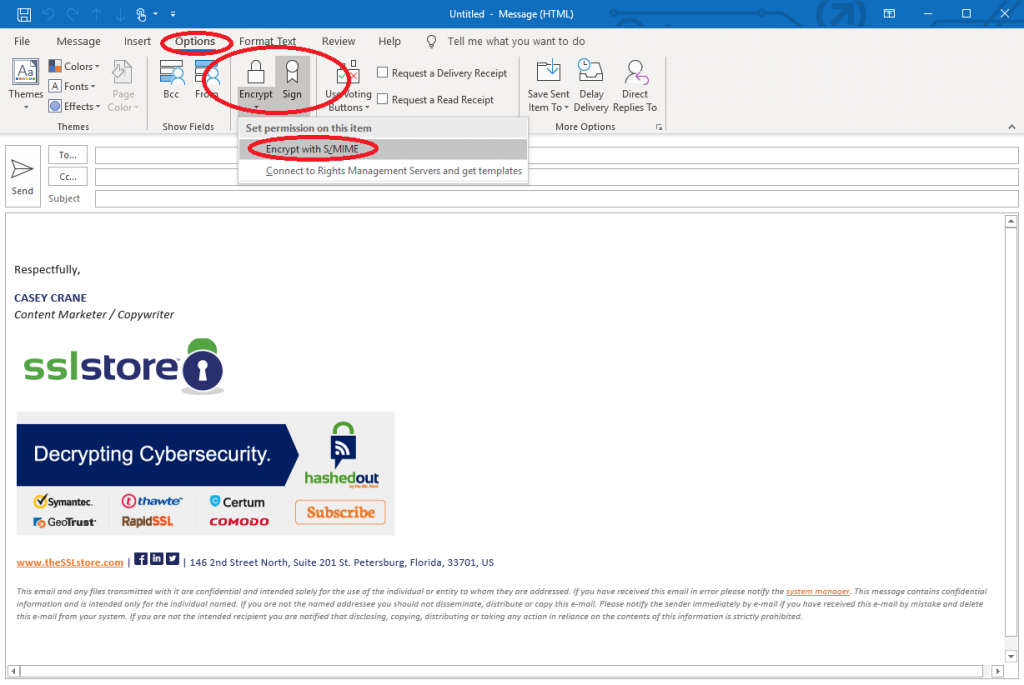

There is also a mechanism that allows a user to encrypt emails when composing them in the Outlook desktop app or in Outlook on the web.

This article shows you how an admin can use Office 365 Message Encryption to encrypt emails without user interaction.
#Outlook for mac sent encrypted emails code#
For some email clients, opening an encrypted message might require manually entering Microsoft account credentials or using a one-time code to open the message in the OME Portal. The required authentication method depends on the email client and may require following a link to re-send the user’s credentials or entering a one-time code that can be sent to the recipient in a separate message. If the recipient is using one of the other supported email clients such as Gmail, Yahoo! or, they will receive a wrapper email, which will direct them to the Office 365 Message Encryption Portal (OME Portal), where they will be asked to authenticate. The message will open as usual but will contain information that it has been encrypted (the same applies to email attachments). If the recipient is signed-in to their Microsoft 365 or on-premises Exchange account and is using one of Microsoft’s email clients, they do not need to take any additional actions. When the encrypted message reaches its intended recipient, they will be asked to authenticate to open the message contents. In this scenario, a message is encrypted as it is sent (before it leaves your Microsoft 365 organization) and the sender does not have to do anything.
#Outlook for mac sent encrypted emails how to#
It has a number of features and configuration options, but here I will focus on how to automatically encrypt emails sent outside your organization by members of a specific group (the Legal Team). Office 365 Message Encryption is a service that is integrated with Microsoft’s email clients (Outlook desktop, Outlook for Mac, Outlook mobile on iOS and Android, and Outlook on the web).

Read on to learn how to create a Microsoft 365 sensitivity label and use it in a transport rule to encrypt emails and files. From the recipient’s perspective, this form of email encryption works seamlessly with Microsoft 365 accounts and offers an intuitive experience for all other email clients and email service providers. From the user’s perspective, it is the easiest to use: it can be configured so that it does not require any additional actions on their part. If you are looking for a user-friendly email encryption solution for your Microsoft 365 organization, there is a native tool for that – Office 365 Message Encryption. There's an internal trust between the mail client and networksolutions.ĭisclaimer: Mac mail requires encryption because it an internal and external trust.Email encryption provides additional layer of information security by making sure only intended recipients can read messages. The domain is attached to the SSL certificate that secures the shared and secure mail server that every web.com email is on is hosting. This certificate prompt happens regardless of whether you have the encryption connection enabled in the POP/IMAP account settings or not. You won't send/receive because the certificate expired prompt will come pop up if it's not secure. The email client talks to mail server to see if it is secure. The first thing when Outlook or any email client communicates with a mail server. The whole conversation about encryption started when we received certificate errors every time we loaded Outlook with an "encrypted connection" Here are the notes from the conversation: I had an interesting conversation about not utilizing Outlook encryption email settings that makes me want to get some more validation from this community.


 0 kommentar(er)
0 kommentar(er)
